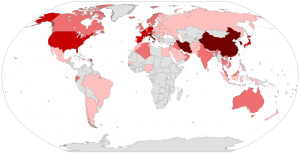Here in Washington State, we have schools closing because of the Corona virus. We have the added burden of students who do not have access to the internet at home. This is not unlike other obstructions/opportunities/challenges I have faced in the past as an instructional designer, for instance, getting curriculum to prisons. Bryan Alexander, who has been doing some excellent writing on education and the virus has a post entitled “COVID-19, academia, and the big push online: an update” that sums up a lot of these issues and succinctly points out the following:
“…the digital divide means unequal access to bandwidth, which can limit use of video and large files. Faculty are not universally schooled, practiced in, and happy about teaching online. Campuses may lack sufficient staff to enable a big, fast online push. This is also happening during the middle of academic terms in many instance, which makes the transition even more difficult.”

By way of a relevant case, Lindsay McKenzie in a recent article in Inside HigherEd discusses the transition that universities in Shanghai have recently made in shutting down their physical college and moving rapidly online: “Preparing to teach a course online for the first time usually takes several months. Faculty at institutions in China have done it in less than three weeks — a remarkable feat.” (Emphasis is mine.) In an emergency situation, all of the things that we know are important in successful online learning might go out the window (hopefully the situation is only temporary). A lot of the best practices in online learning, such as discussion, group work, community building will probably have to take a back seat to just content delivery.
I am wondering what templates could be built in an LMS or in WordPress that would allow faculty to learn the tools while they build out courses. I think a lot could be done in three weeks. But wouldn’t it be better to have courses all ready prepared for anything? Some tools to consider could include the following for fully offline situations:
- Spoodle: LMS on a thumb drive
Stephen Grono discusses his stand-alone version of Moodle, called “Spoodle” that fits on a thumb drive in this Moodle forum. All of the student’s course materials could be accessed through a thumb drive that runs Moodle. - Canvas LMS offline
An instructor can export a Canvas course to make it available as HTML – it does not include assessments or discussion forums. This could then be put on a thumb drive and sent out to students. Canvas course materials can also be exported as ePub files for - Internet Essentials from Comcast
This was a suggestion from a conversation Lucy Gray is currently having on Facebook about elearning tools to support possible school closures in Illinois. Many students may not have internet at home but their data plan might include using their phone as a wifi hotspot.
My critical question as an instructional designer is how to build in the flexibility to a curriculum that it can be nearly instantly adapted in the case of an emergency. This feels like something that should be akin to Universal Design for Learning. It sounds simple at first but when thinking about managing student interactions, assessment, communication, content delivery, etc. It begins to feel like designing a house that can convert into an airplane, and actually fly, and then be folded up Ikea flatpack style and sent to the Philippines.
Questions I am interested in further exploring include:
- How do we teach faculty how to teach online in 3 weeks? What is the bare minimum they need to know?
- What kind of access do are students have in a state of emergency?
- What should we be doing differently in our design of course shells and templates for faculty?
- How do we best help the student transition to online learning in times of emergency?
The illustration below is incomplete, but I think you get the idea. How do we design classes for any given condition?
I would be interested in learning more about plans that your institution may have in place to get faculty and students up to speed around possible campus closures. Comment below, find me on Twitter @geoffcain, or drop me an email at consult@geoffcain.com





